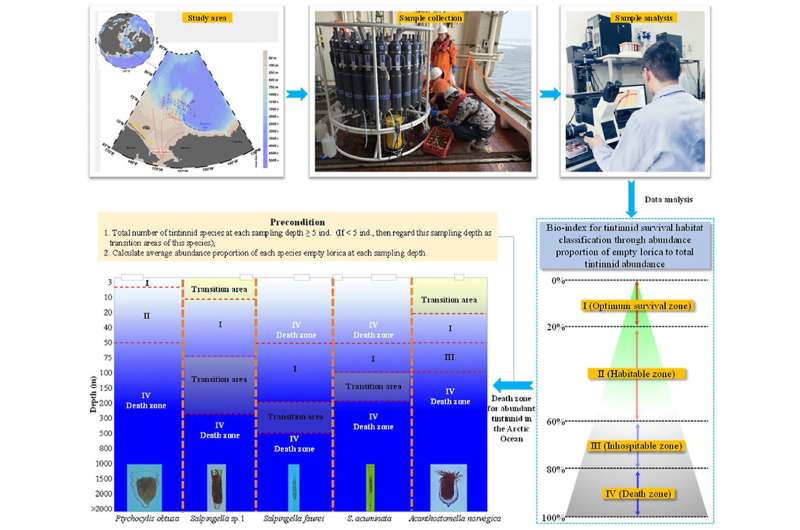This article has been reviewed according to Science X's editorial process and policies. Editors have highlighted the following attributes while ensuring the content's credibility:
fact-checked
trusted source
proofread
Novel bio-index helps indicate future Arctic climate change through microzooplankton

The Arctic Ocean is experiencing rapid changes due to global warming. It contains complex water masses with unique hydrographic features and zooplankton communities.
Planktonic ciliates are a kind of microzooplankton. They are single-celled protozoa in the marine ecosystem, and can act as bioindicators of various oceanographic conditions. Planktonic ciliates are composed of aloricate ciliates and tintinnids, and the latter is used as bioindicator for indicating different water masses.
Recently, Dr. Wang Chaofeng of Prof. Zhang Wuchang's team from the Institute of Oceanology of the Chinese Academy of Sciences (IOCAS) and his collaborators investigated the full-depth vertical distribution of planktonic ciliates and created a novel bio-index for indicating habitat suitability of tintinnids in the Arctic Ocean.
The study was published in Marine Environmental Research on Feb. 18.
The researchers found that planktonic ciliate community structure showed obvious variations in different water masses. They classified habitat suitability of tintinnid abundant species through a novel bio-index.
"Pacific-origin tintinnid invaded in the Canada Basin, revealing a rapid borealization progress of Arctic microzooplankton," said Dr. Wang. They also found that five water masses occurred in the Arctic Basin, and each of them had unique tintinnid community structure.
Aloricate ciliates played a key role in pelagic marine ecosystem compared to tintinnids, with average abundance proportion to total ciliates > 95%. Additionally, its large (>30 μm) and small (10–20 μm) size-fractions were dominant in shallow and deep waters, respectively.
Combined with the dominant Pacific-origin species Salpingella sp.1 in the Pacific Summer Water and three new record tintinnid species found during this survey, they speculated that the borealization progress became more rapid in the Arctic Ocean.
"The habitat suitability of tintinnid abundant species was characterized by the Bio-index, which revealed a distinct death-zone for each species," said Dr. Wang. Compared with previous studies, the increase of Pacific Summer Water thickness and average temperature might be the reason for more ciliates with small body size invading the Arctic Ocean.
"Additionally, through comparing variations in survival habitat of abundant tintinnids, we can monitor and indicate the future Arctic climate change," added Dr. Wang.
More information: Chaofeng Wang et al, Full-depth vertical distribution of planktonic ciliates (Ciliophora) and a novel bio-index for indicating habitat suitability of tintinnid in the Arctic Ocean, Marine Environmental Research (2023). DOI: 10.1016/j.marenvres.2023.105924
Provided by Chinese Academy of Sciences

















